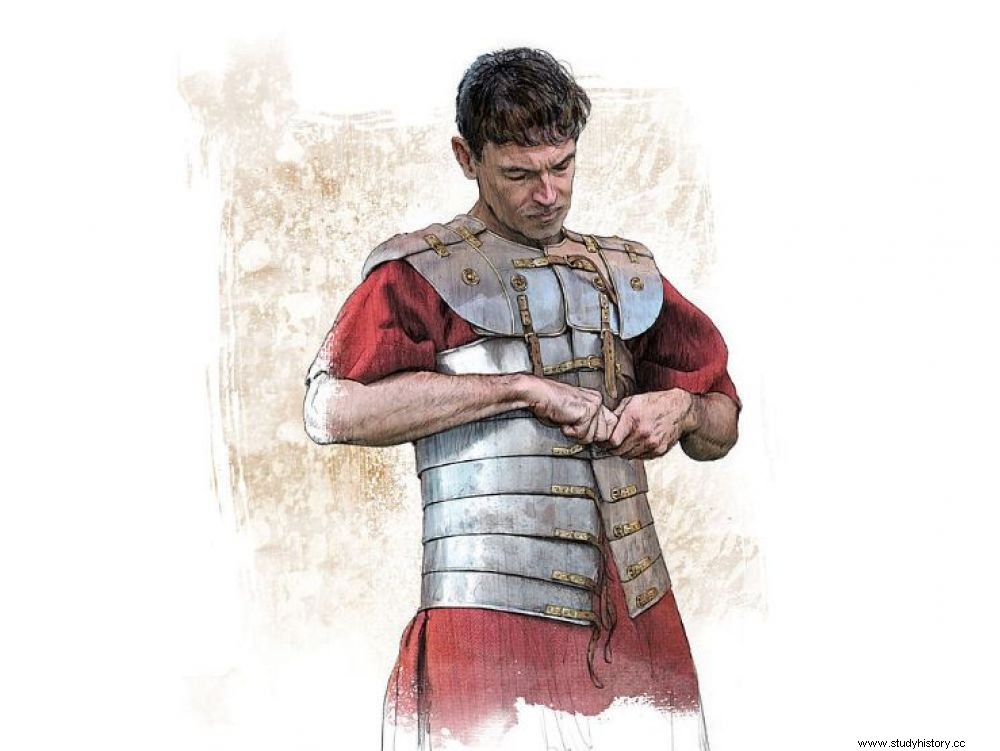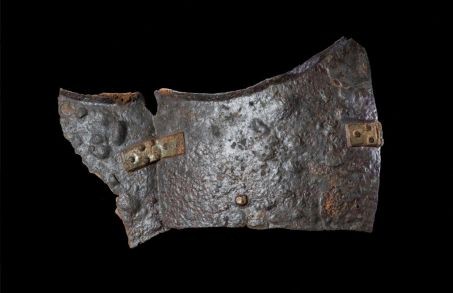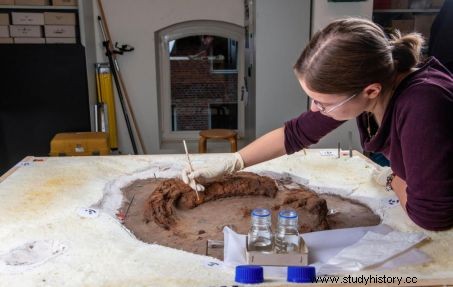The cuirass of a Roman soldier involved in the Battle of the Teutoburg Forest (Germany) in 9 CE has been discovered in a remarkable state of preservation.

Reconstruction of articulated Roman armor from the 1st century AD, model found in Kalkriese, Germany.
It all started with a beep-beep during 2018… While scanning a wall with a metal detector in an excavation trench, archaeologists from the museum in Kalkriese, Germany, heard the alarm of their device resound. Sign – but the researchers did not know it yet – that they were going to make one of their most important discovery. That of a Roman armor, the most complete and best preserved ever encountered to date.
For years, research has been carried out in the forest of what is now Kalkreise, in Teutoburg in Westphalia (Germany). It was here that in 9 CE, Roman legions suffered one of the most bitter defeats in their history. More than 20,000 men - 15,000 legionnaires and 5,000 auxiliary troops - placed under the command of Publius Quinctilius Varus (the legions of Germania XVII, XVIII and XIX) were massacred or their men enslaved. Defeated by a powerful coalition of Germanic peoples led by the Cheruscan leader, Arminius. This defeat brought a sudden halt to the policy of Roman imperial expansion. Witnesses to this carnage, thousands of remains of weapons and military equipment (swords, javelin tips, arrows, daggers, helmets, etc.) have been regularly exhumed since the final location of the battle was established in the 1980s.

Close up of one of the iron elements of Kalkriese's armor. ©Museum and Park Kalkriese
This is how after extracting the block of earth from which the signals of the metal detector came in 2018, the researchers took the precaution of scanning it. This is to avoid seeing the metal objects it may contain oxidize in contact with the open air. And it was during this analysis that they were surprised to discover the presence in the sediments of a splendid Roman armor. "This is a pattern known as lorica segmentata , explains Yann Le Bohec, specialist in the Roman armies, joined by Sciences et Avenir. Representations of this articulated breastplate, worn by legionaries and praetorian guards, can be seen in the bas-reliefs of Trajan's Column in Rome. It consisted of a series of iron plates linked together by hinges and leather straps that allowed adjustments and adaptation of the armor to each person's morphology ".
In the past, only tiny fragments of these cuirasses had been collected in the Iberian Peninsula, in Brittany, or in the Danube region.
It all started with a beep-beep during 2018… While scanning a wall with a metal detector in an excavation trench, archaeologists from the museum in Kalkriese, Germany, heard the alarm of their device resound. Sign – but the researchers did not know it yet – that they were going to make one of their most important discovery. That of a Roman armor, the most complete and best preserved ever encountered to date.
For years, research has been carried out in the forest of what is now Kalkreise, in Teutoburg in Westphalia (Germany). It was here that in 9 CE, Roman legions suffered one of the most bitter defeats in their history. More than 20,000 men - 15,000 legionnaires and 5,000 auxiliary troops - placed under the command of Publius Quinctilius Varus (the legions of Germania XVII, XVIII and XIX) were massacred or their men enslaved. Defeated by a powerful coalition of Germanic peoples led by the Cheruscan leader, Arminius. This defeat brought a sudden halt to the policy of Roman imperial expansion. Witnesses to this carnage, thousands of remains of weapons and military equipment (swords, javelin tips, arrows, daggers, helmets, etc.) have been regularly exhumed since the final location of the battle was established in the 1980s.

Close up of one of the iron elements of Kalkriese's armor. ©Museum and Park Kalkriese
This is how after extracting the block of earth from which the signals of the metal detector came in 2018, the researchers took the precaution of scanning it. This is to avoid seeing the metal objects it may contain oxidize in contact with the open air. And it was during this analysis that they were surprised to discover the presence in the sediments of a splendid Roman armor. "This is a pattern known as lorica segmentata , explains Yann Le Bohec, specialist in the Roman armies, joined by Sciences et Avenir. Representations of this articulated breastplate, worn by legionaries and praetorian guards, can be seen in the bas-reliefs of Trajan's Column in Rome. It consisted of a series of iron plates linked together by hinges and leather straps that allowed adjustments and adaptation of the armor to each person's morphology ".
In the past, only tiny fragments of these cuirasses had been collected in the Iberian Peninsula, in Brittany, or in the Danube region. "These hinged or slat armors were introduced by Emperor Augustus. It was an improvement over chain mail – protection that was already used in the Bronze Age – or scale breastplates. The latter consisted of a leather jacket on which were attached metal "scales", equipment attested in armies in the 17th century BC. J.C!".

Laboratory extraction of Roman armor from Kalkriese (1 st century). © Museum and Park Kalkriese
In addition to this discovery, the remains of a hindrance were also unearthed. It is an iron collar fitted with a kind of handcuffs, used to chain prisoners. "To avoid suffering the dishonor of defeat and enslavement, many Roman soldiers committed suicide in Teutoburg. Of those who survived, some attempted to flee, but all were caught" , continues Yann Le Bohec. Perhaps the wearer of the armor was one of them.
Still in progress, the delicate and slow extraction of all the iron plates, rivets and fasteners continues in Germany for an exhibition of this exceptional armor, at the Kalkriese museum, in 2022.
The Teutoburg disaster

The Battle of Teutoburg between the Legions of Varus and the Germanic Tribes of Arminius, work of the painter Oscar Anton Koch, 1909.
Caught between marshes and hills from which the German fighters descended in continuous waves, the 25,000 Roman infantry and horsemen were torn to pieces in the forest of the current Kalkreise, in Teutoburg in Westphalia (Germany) in 9 AD. Later, the Roman historian Dion Cassius (155-235) will affirm that the legionnaires who were at the rear, unaware of the massacres at the front, continued to throw themselves into the mouth of the wolf. Faced with disaster, their leader Publius Quinctilius Varus would rather commit suicide than fall into the hands of the enemy, and their Cheruscan leader Arminius. And Varus' name will forever be associated with the disaster, the clades Variana . "Ancient texts tell that the captured Roman officers were all sacrificed by the Germans to their gods" , specifies Yann Le Bohec, specialist in the Roman armies. In his book 57, Dion Cassius also tells that in the year 15, returning to the scene of the battle, "Germanicus in his expedition against the Germans (…) collected the bones of the soldiers who fell with Varus, gave them a burial and covered up the signs "…Those eagles of the XVII, XVIII and XIX legions whose loss to the enemy had been felt as the height of dishonor for Rome. Horrified, the Roman legionnaires of the new expeditionary force discovered on this occasion that Arminius, who knew well the fear for any Roman not to be buried, had ordered that the bodies of the thousands of vanquished soldiers were left unburied on the battlefield, or even crucified or mutilated. Teutoburg was a name reviled by Rome throughout its history!
